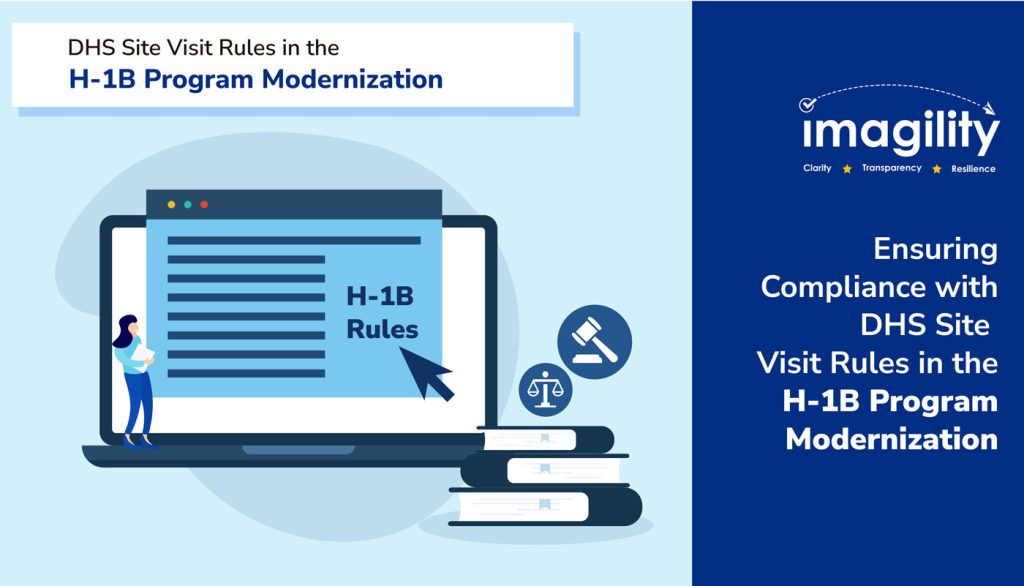The Department of Homeland Security (DHS) has announced new rules to modernize the H-1B visa program. These rules highlight the importance of following site visit requirements, giving U.S. Citizenship and Immigration Services (USCIS) clear authority to conduct inspections. The goal is to ensure compliance with the program’s rules and prevent fraud.
The DHS announced the new rule to modernize the H-1B visa program on December 18, 2024, with an effective date of January 17, 2025. This rule builds on a previous final rule announced in January 2024, which had already improved the H-1B registration and selection process. The updates aim to streamline the approval process, increase flexibility for employers and workers, and strengthen program integrity.
While U.S. Citizenship and Immigration Services (USCIS) has always conducted site visits to verify information in H-1B petitions, the new rule formally confirms this authority. This formalization underscores the importance DHS places on maintaining the program’s integrity. Previously, participation in Fraud Detection and National Security (FDNS) site visits was voluntary, allowing employers to opt out without direct consequences. Under the new rule, participation in these site visits is now mandatory. Employers who refuse to participate may face significant penalties, including denial or revocation of H-1B petitions.
Understanding Site Visits
USCIS site visits, conducted under the Administrative Site Visit and Verification Program, aim to verify the accuracy of information provided in H-1B petitions. These visits may include
- Physical inspections at the employer’s headquarters, satellite offices, or third-party worksites.
- Interviews with H-1B beneficiaries, supervisors, and other relevant individuals.
- Review of records to ensure compliance with immigration laws.
USCIS officers may also conduct virtual or telephonic inspections and use government databases and public records for verification purposes. These inspections can occur at the petitioner’s headquarters, satellite locations, or any site where the H-1B beneficiary works, including third-party worksites.
Importance of Site Visit Compliance
Site visits play a key role in keeping the H-1B program fair and trustworthy. They help USCIS
- Spot and prevent fraud or misuse of the program.
- Ensure employers follow program rules.
- Protect U.S. workers by ensuring fair competition.
Between FY 2019 and FY 2023, USCIS conducted over 32,000 compliance reviews, uncovering a 19% non-compliance rate. Non-compliance was more prevalent at third-party worksites compared to primary employer locations.
Consequences of Non-Compliance
If employers refuse or fail to cooperate with site visits, they face serious consequences, such as
- Denial or revocation of H-1B petitions related to the inspected worksites.
- Losing access to skilled workers, financial setbacks, and disruptions to business operations.
What Employers Should Do
Employers should be prepared for potential site visits by
- Ensuring all records and documentation related to H-1B petitions are accurate and readily accessible.
- Training the staff on compliance requirements and how to handle a site visit.
- Maintaining transparency and cooperation with USCIS officials during inspections.
By adhering to these practices, employers can facilitate smooth inspections and demonstrate their commitment to the integrity of the H-1B program.
Business Impact
USCIS estimates the average duration of a site visit to be 1.09 hours, including interviews with both the beneficiary and a supervisor or manager. Non-compliance can lead to penalties, hurt business operations, and limit access to skilled talent. By staying compliant, employers can avoid disruptions and show their commitment to the H-1B program.
Best Practices for Employers
To avoid penalties and ensure seamless operations, H-1B employers should
- Maintain accurate records: Ensure all petition-related documents are up-to-date and easy to access.
- Train your team: Familiarize employees with site visit procedures and USCIS requirements.
- Enhance transparency: Address compliance issues and work cooperatively during inspections.
Following these steps can help employers meet DHS standards, protect their operations, and maintain the integrity of the H-1B program.
Conclusion
The DHS’s new rule highlights the importance of compliance with clear site visit guidelines. Employers should understand and follow these rules to avoid penalties and stay aligned with program requirements. Additionally, employer participation in site visits is now mandatory, making it essential for businesses to cooperate fully to maintain their H-1B eligibility.
For more detailed information, refer to the official DHS announcement or our blog on H-1B Program Modernization: A Summary of the DHS Final Rule.









